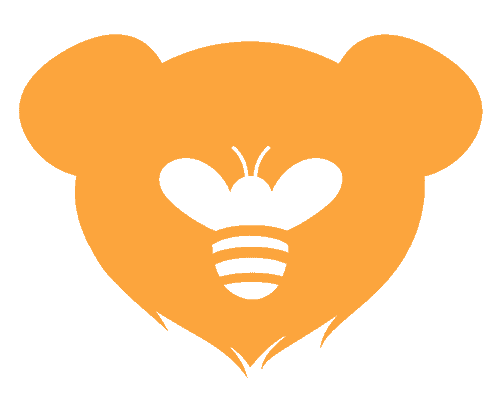Bees are incredible creatures who spend their entire life working for the common benefit of the hive and the bee society. Everything they do is centered around the beehive and ensuring that the queen bee is sustained and thriving, and even when the queen bee eventually dies, there is an order in place to grow a new queen that they can serve.
Worker bees fly outside the hive for approximately four to five hours per day, and they will go away in the early evening. They will also go away if the weather conditions worsen and they cannot operate optimally, and finally, they go away for the cold autumn and winter months.
Bees live a strictly regimented life, and older bees are responsible for guarding the hive’s edge and sleeping on the edge. These bees are the last to go away and will be the last to get inside the hive at night.
The Times Bees Go Away
There are 10,0000 – 20,000 species of bee, including many wasplike and fly like bees and many have different habits, including some which are nocturnal.
Bees never really go away because they remain in the environment irrespective of the time of day or year’s season. They do, however, return to the hive every evening as well as at the end of Summer.
Worker bees will leave the hive in the mid to late afternoon every day during the warmer seasons. Their roles are twofold.
- Foraging
- Scouting
Interesting facts about their foraging behavior.
- The foraging bee will fly up to 12km away (this depends on the food sources and is normally only 3 km).
- In their foraging role, they will fly up to 12 km (8 miles) and visit approximately 40 flowers per minute, depending on the floral type.
- When they fly away from the hive, they reach average speeds of 20 km/h (12.5 mph).
- When they are fully laden with pollen and are returning to the hive, they will reach average speeds of 20 km/h (12.5 mph).
- They will make between five to fifteen trips per day.
- The optimal temperature at which the worker bees operate is between 16C – 30C.
What Daily Conditions Will Make The Bees Go Away?
The bees will return to the hive in the following conditions.
- Below 13C, they permanently return to the hive until the temperature increases.
- Between 13C to 16C, they will reduce their activity.
- Above 30C, they reduce the foraging but increase water collection.
- Above 37C, they cease foraging altogether.
- When the wind is blowing at 40 km/h (25 mph).
- When the sun goes down.
The time worker bees are out depending on the temperature and therefore is not the same every day. Interestingly, bees have been observed to know the time of day and will change the areas they forage depending on the time of day and the sun’s position.
The bees return to the hive at the end of the day. They sleep for up to eight hours a day.
Some bees have been observed to sleep during the day outside the hive, sometimes in flowers, from which they were collecting pollen.
What Seasonal Conditions Will Make The Bees Go Away?
Bees operate on a seasonal basis. When the Spring temperatures increase and the plants begin to grow in spring, the bees will appear, scouting, foraging, and collecting water.
While they return to the hive at the end of each day and during non-optimal weather conditions, they generally stay in full operation for the whole warmer season.
At the end of the Summer months and the beginning of Autumn, the bees go away, back to the hive.
While bees often go into a hibernation state, they are not completely inactive in the Winter and fall and do occasionally leave the hive to remove waste and dead bees.
The bees do not collect nectar during these periods and will wait for the warmer seasons; they mostly remain inside to keep warm.
When Winter comes to an end, the viable adult bee population is at its lowest number.
During this period, the queen increases egg production. There is a squeeze on resources with the food supplies running in short supply as there are more bees to feed on when the eggs hatch, the highest risk of the hive facing starvation is during late Winter and early Spring.
The Duties Of Bees
However, while the bees seem to go away to the casual observer, they are returning to the hive as the conditions require.
A small hive will host approximately 20,000 bees (which weigh approximately 5 lbs. together), and a big hive up to 100,000 bees (which weigh 25 lbs. together).
The beehive is made from wax and consists of interconnected hexagonal-shaped chambers. (Interestingly, this is one of the most efficient shapes) and being hexagonal means that the chambers fit together in the same way as jigsaw puzzle spaces, so there are no empty, wasted spaces in the hive.
The typical cycle followed by bees is influenced by several factors, which means it is important to look at a bee’s activity.
The activity and visibility of the bees will depend on the different roles each bee types carry out for the hive’s benefit.
- The queen bee
- Drone bee
The Queen Bee
Bees live in a beehive that revolves around the queen bee, and everything is done to keep her in an optimal breeding environment.
The queen bee is the center of everything, and apart from keeping the beehive together, she is also responsible for producing the eggs needed to keep the hive populated.
The queen bee will only leave the hive under two conditions.
- To mate
- To form a new hive.
A Queen Bee Will Leave The Hive To Mate
When a queen bee dies or becomes nonproductive, for the survival of the hive, she has to be quickly replaced. It generally takes two to three days.
The worker bees use a fertilized egg from the previous queen (which is only three days old) and place them in a specially constructed “queen cell.”. After three days, the egg hatches, and about eight days later, the new queen emerges.
To keep the hive viable, different worker bees may use several fertilized eggs, and there may be few new “queen” bees. There can, however, be only one queen, so if the other queen eggs haven’t yet hatched, the new queen will sting the unhatched eggs, killing the pupating bees.
If both queens hatch simultaneously, there is a royal death match until only one queen remains. This process ensures that the strongest, most viable queen ends up in the hive.
During the first two weeks of her adult life, the queen bee leaves the hive for two to three days on mating flights. During these flights, she will mate with twelve to fifteen males and store the sperm in an organ called a spermatheca which stores more than 5 million sperm cells.
During her lifetime, she will draw semen from the spermatheca to fertilize the eggs.
The process from queen loss to egg stage takes about 29 days.
In her life, she will produce up to 800,000 eggs. For the rest of her time, the queen bee, dragging her abdomen, walks through the hive. She checks the ‘brood chamber’ at the bottom of each honeycomb cell; if it is empty, she will drop her abdomen into it to lay an egg.
To Form A New Hive
A queen bee will only leave the hive after mating if the hive splits, and she forms a swarm with half the worker bees, creating another colony separate from the original. When this happens, the remaining bees grow a new queen.
- During a twenty-four hours cycle.
- During the different seasons of a year.
Drone Bees
In a healthy bee colony, about fifteen percent of the bees will be drones, and they serve one function: mate with the new queen bee. They are kept around by the worker bees to be available of the queen dies, and a new one requires to mate.
On sunny afternoons the drones leave the hives for up to four hours at a time and assemble with other drones in areas called Drone Congregation Areas. (DCAs).
During the flight, the drones will be available to mate, not only with the new queen from their colony but also with any queen from other colonies. It ensures that a genetic variation is introduced to each of the hives.
After approximately four hours of flight, the drone runs out of fuel and has to return to the hive. The drone can return to any hive without opposition. If the drone bees mate successfully, they fall to the ground and die.
Drone bees live for fifty-five days, and only a small percentage die inside the hive as most will leave to die to help keep it clean and disease free.
At the beginning of Winter, some drones are killed off by the worker bees to prevent them from becoming a drain on the hives’ food supplies. Drone eviction occurs when at the point when a colony stops feeding its drones due to a lack of incoming pollen supplies. Over several days, the drone bees become weakened and are forcibly removed from the hive.
The Female (Worker) Bee
The female bees are known as worker bees, and they make up approximately 85% of the hive’s bee population.
At different times of a bee’s lifecycle, they take on different responsibilities, which include.
- Cleaning of the hive.
- Building new honeycomb and reinforcing the existing structures of the hive
- The proliferation of the nest includes feeding larvae with royal jelly and nursing the young bees.
- Construction of the hive involves building cells.
- Heating the hive.
- Storing food on the edge of the nest.
- Controlling the size of the drone population.
- Guarding the hive.
- Foraging for food.
Newly Emerged Bees
As soon as the new bee emerges from the capped brood cell, it cleans out its cell and those adjoining it, preparing them for new eggs.
These new “cleaning” bees will also remove the dead bodies of any bees which died in the hive.
They will also care for new larvae and young nurse bees.
Mid-Life Worker Bees
During this cycle of a worker bee’s life cycle, their role changes to that of maintaining the hive. During this time, they will build new cells, heat the hive (by vibrating their wings), store food, and control the size of the drone population.
Mature Worker Bees
The oldest worker bees do all the dangerous work, including foraging and guarding the hive, because these are the most disposable.
During this time, they will fly up to 500 miles and wear themselves out.
When they sense the end is approaching and they are going to die, they leave the hive so as not to burden the hive.
The Female Attendant Bees
Approximately twelve female bees are assigned the role of queen attendant bees.
The attendant bee’s roles are
- The female attendant bees are responsible for feeding the queen bee.
- In between laying sessions (where she can lay 1,500 eggs a day), the queen bee stops and is groomed by the attendant bees.
Conclusion
The bees never truly go away; when they are not seen, it is because they have returned to the hive. As most bees only travel between one and three miles per day, they are still in the vicinity but hidden away in the colony.
The bees will go away at the end of each warm day and when it gets too hot or cold, or the wind blows too strongly. The bees also go at the end of Summer when the temperatures reduce, and it is no longer viable to collect pollen.
References

